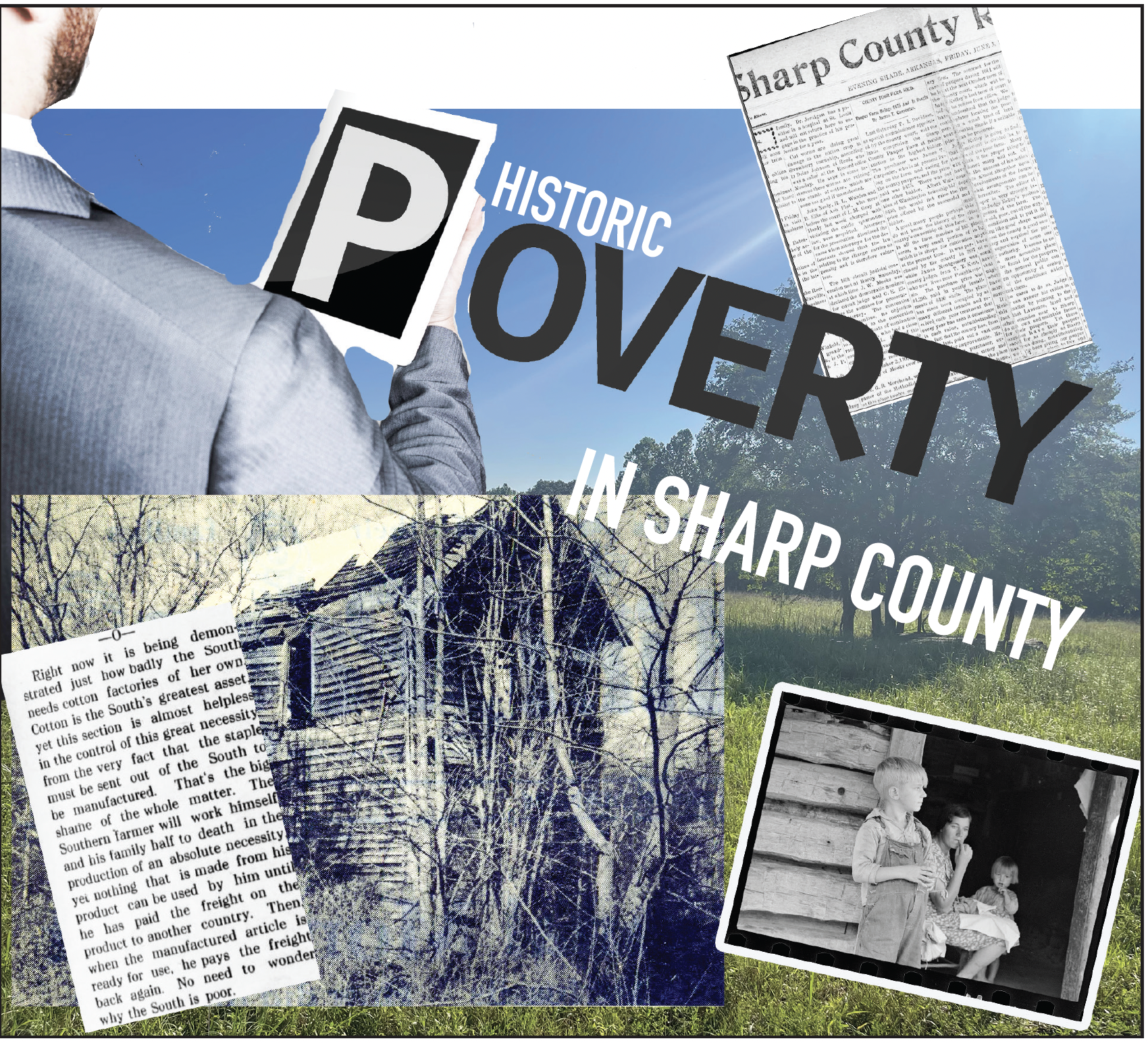By Tammy Curtis, Publisher, Managing Editor
EDITOR’S NOTE:
Oftentimes the stories housed within the walls of structures that dotted America’s landscape die with them. The goal of this three part series on poverty in Sharp County is to highlight how Sharp County residents have historically assisted the less fortunate, as well as exploring manners in which poverty was dealt with in the pre-New Deal Sharp County.
Most have heard the term “poorhouse,” or maybe even joked about it when they were low on funds. Poor houses were very real and served a major purpose in assisting those who, for whatever reason, may have fallen on hard times and were unable to support themselves or their families. The pauper or poor farms and houses of yesteryear were not places anyone wanted to end up, but sadly many did. This was a chapter in the history of rural America that has not been elaborated on much other than records of governmental financial transactions to purchase the farms and U.S. Census records surrounding the thousands of people who were housed in poor houses across the South.
While there are countless photos of sharecroppers from the era and later, many a pictorial history during the Great Depression and New Deal, few photos were taken of the daily activities within the poorhouses. This was likely because of the shame and despair associated with living there. There are many historical photos of the structures, few candid shots of the people exist.
Poor farms began to quickly dot the American landscape, not just the South, around the turn of the 20th century in the mid to late 1800s. They became a catch all for anyone who could not care for themselves. According to an extensive study at Murray State University, in many cases criminals and mentally ill where housed together. Today our modern public assistance system with cash, food, medical, and housing assistance has diminished the memory of when the poor had to move into local institutions to get the help needed to survive.
Why such high poverty in the state?
It is as simple as supply and demand. Around the time poorhouses began to be prevalent in most counties within Arkansas a cause and effect type of mechanism in the economy came into play. During this time, many farmers who had previously heavily utilized slave labor for much of the revenue on their farms had transformed into sharecropper or tenant farmer situations.
Research indicates the incomes of white farmer’s incomes were greatly reduced when slave labor ceased in the late 1800s and the downward spiral continued. Perhaps the largest factor that led to increased poverty began to the end of the 1800s when there were virtually no railways within the state. Over 3000 miles of track laid between 1875 and 1895 brought with them many changes, both good and bad, but the worst fell on the farmers.
“Over the hill to the poor-house–my children dear, good-bye!
Many a night I’ve watched you when only God was nigh;
And God ‘ll judge between us; but I will always pray
That you shall never suffer the half I do today. “
Over the Hill to the Poorhouse by Will Carleton (1872) captures some of the dread and foreboding about becoming poor and the need for assistance that faced paupers in the nineteenth and early twentieth centuries.
With the railroad, countless small towns, like Hardy, sprang up. With the railroads, an influx of people from larger cities also came. With them came the need for more agricultural products to sustain the growing populations in rural areas. Cotton production jumped from 29 to 57 percent, according to Census records during this time frame. Cotton was farmed heavily in Sharp County during this time. Timber and coal production also increased significantly in the state. Supplies of cotton could not keep up with the consumers demand, so cotton, the source of many farmer’s income dropped causing poverty rates to escalate.
The South, a region that has historically been the poorest in the nation, is also the one who produces the majority of the nation’s cotton. When the area began to experience wealth, the prosperity the era brought was earned at the cost of poor farmers, sharecroppers, and recent immigrants. It is easy to see how within years the need for a place for those who were unable to support themselves or their families became real.
Others were aging with little or no marketable skills in the job market. Still others who ended up at the poor farm had become ill from improper nutrition due to being poor and were weakened and unable to work.
The aiding of a pauper by another person in the community was not unheard of prior to the establishment of poorhouses. Many areas provided outdoor relief to paupers that was normally administered by a person delegated as “Overseer of the Poor”, who was often a local elected official. Usually a budget of tax money was set aside to help the poor by providing food, clothing, or even medical treatment when family members, friends, or church congregations could not provide enough aid.
Other methods of supporting the poor were sometimes utilized including contracting with a person in the community to care for a group of paupers or auctioning off the poor, which allowed the lowest bidder to use the pauper’s labor for free for a specified period of time in exchange for food, clothing, housing, and healthcare. Oftentimes, the paupers died while living on the farms. Cemeteries are often located on the grounds of the pauper homes or farms, like the one in Sharp County.
How were poor houses established?
Poorhouses were created in the United States based on models used in England.
In Arkansas, Benton County was one of the first to establish poor houses or pauper farms in 1861.
An entry in the court records declared John W. Phleming was one of the state’s first paupers in Benton County. The county sheriff was ordered to auction him to the lowest bidder on April 16, 1861, for a twelve-month term of service. During this time, the man was property of the county and could be housed at the farm but was required to work to earn his room, board and food. This was the situation with most declared paupers.
Sharp County wasn’t far behind in establishing a pauper farm. In Oct. of 1887, the county quorum court under Judge James Montgomery voted and purchased 165 acres of land near the present day Maxville community in Washington township to establish the pauper farm.
The contract to determine who would oversee the farm was conducted by a bid process. A.H. Vance was the first manager of the pauper farm. His bid of $330 for the year was to take care of the paupers at the farm. Under the contract, Vance was also allowed to make extra income by farming the land. The pauper farms were designed to be self-sufficient with the labor of those who could still work doing the gardening, farming and assisting with upkeep. Many times, those forced into the pauper houses were mentally ill, with no family, aging or disabled, creating another set of unforeseen problems with the plan for upkeep, maintenance and actual production at the farms.
Historical Sharp County Records from the Sharp County Historical Society and courthouse indicate the land for the poor farm was purchased from T.T. Kent who lived near Poughkeepsie for $1200. The purchase price was payed in three, four hundred dollar payments. Records filed at the county state it was created “for the purpose of keeping the paupers of said county inside. Suitable arrangements shall have been made for taking care of them in the poor farm of the county.”
Who cared for paupers before the poor houses?
Prior to the purchase of the farm, if a person was declared a pauper, someone was designated to support them and the cost was paid by the county. One such pauper, Benjamin Phillip came to need the services of the poor farm in 1881. J.S. Phillips was allocated $250 for the year to take care of Phillips until Nov. 27, and an additional $23.30 for the remainder of the year.
Another pauper was mentally and physically incapacitated. Miss Ann E. Cash had no relatives to support and care for her. John Wolfe was given custody of Cash and paid $10 a month for her care.
Historical records from the Sharp County Record newspaper indicated the poor house had steadily fallen into a state of disrepair over nearly three decades, despite caretakers having been paid to maintain the property. In June of 1910, the county sold the poor house to James T. Carpenter for only $475. He temporarily took over the care of the paupers residing on the farm until they were relocated to a farm near Evening Shade. An article appearing in the newspaper on June 3, 1910 stated, “The place is old, poor, out of the way, in bad condition and to put it in anything like good shape would have cost the county a good sum of money and required the personal supervision of someone having authority. It seems to us that a more accessible place might be found for the paupers where the general public can have an opportunity of seeing more of the conditions which surround them.”
At this time the transition of the care of paupers seemed to move backward, to either admitting them to State Hospitals or placing them with relatives.
Although the poor farms were necessary in many Arkansas counties in the first part of the twentieth century, the need for them dropped off beginning in the 1930s. The last paupers who were recorded to have resided in the Sharp County Pauper Farm were Bert Patterson, a 53 year old single man, and 88-year old Fannie Taylor in 1934. This was about the time President Franklin D. Roosevelt’s New Deal programs gave birth to a new era in public assistance that is still ongoing today.
Where is it now?
Dying with the structure were the stories from the people who were forced to spend time in the walls of the poor house. The skeletal remains of the main home on the farm remained until at least 1990. Currently a small overgrown floor structure is all that remains of three generations of some of the county’s first documented care of indignant people in Sharp County. It is located just off East Cardinal Road near Cave City in the Maxville Township.
While poor houses served a purpose, the lessons learned from housing the poor also brought with them, insight into the complex needs of assisting American’s underprivileged. Poor farms were in actuality the progenitor to various government programs including elderly, mental health and nutritional care.
Next week we will explore how communities in Sharp County came together during the mid part of the 20th Century again to help each other when new food preservation techniques made their way into the American landscape.

